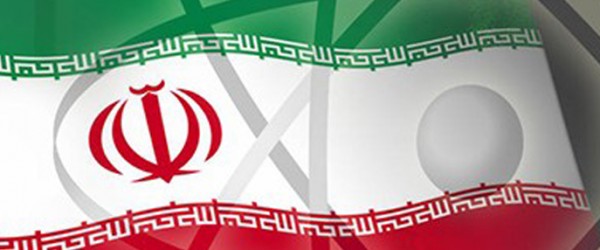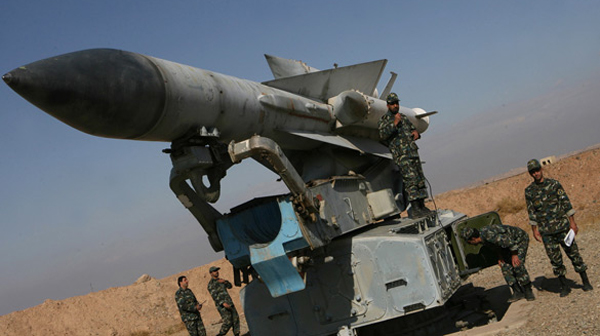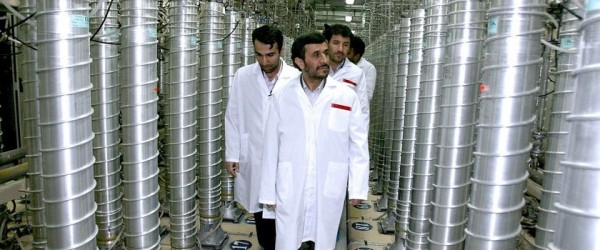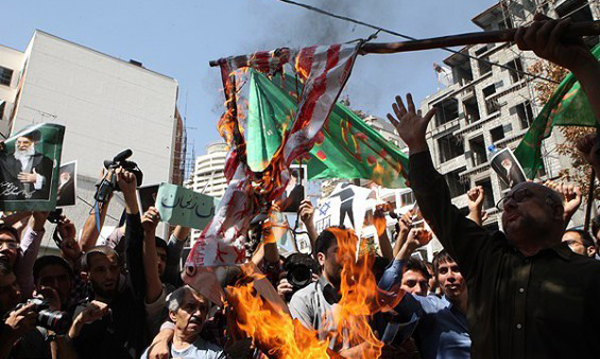
Why We Should Not Order a Military Strike on Iran’s Nuclear Facilities
Culture, EssaysAt his Nobel Peace Prize acceptance ceremony, President Barack Obama told the audience, “Part of our challenge is reconciling these two seemingly irreconcilable truths – that war is sometimes necessary, and war at some level is an expression of human folly.” (Abramowitz). Leaving aside the ridiculousness of preemptively awarding a Nobel Peace Prize to a wartime and in a limited way, warlike President, there is something to be said that war is a result of human failure. There are times when war is not chosen but is instead imposed upon a nation. All states involved have failed at a basic level of human dignity in the event of war if their policies and actions were not effectively chosen or crafted well enough to keep armed chaos and death from happening. This moment in the history of the Greater Middle East represents a unique and pivotal transitionary period ripe with power struggles and hopes for political reform. During a 2012 October lecture, Senior Research Fellow Roxane Farmanfarmaian of the Global Policy Institute stated that now is also a time rife with the dangerous possibilities of a regional war stretching from Lebanon’s Mediterranean coast all the way to the Afghanistan-Pakistan border. This underscores the seriousness of the current situation and gives pause for a sober and careful assessment of the options available and costs to bear in mind when responding to the conceivable emergence of a nuclear armed Iran. The costs certainly outweigh the benefits to the United States, alone or in concert with Israel, to launch military strikes against Iran’s nuclear facilities in order to prevent any possibility of an Iranian nuclear weapons program. The most optimistic outcome cited by experts is merely a delay of four years until Iran restores its uranium enrichment program (Abramowitz). The consequences of a military strike make an attack not only foolish but also futile.
Cross-border violence is now occurring between Syria and anti-Syrian factions in Lebanon as well as between Turkey and Syria. A new Cold War has begun between states allied with Iran in the region (Syria and the Hezbollah-dominated Lebanese government) and the Sunni Gulf states allied with Saudi Arabia (U.A.E., Kuwait, Bahrain, Qatar, and Oman). These players have made the decision to use Syria and now increasingly Lebanon as the theater of choice for a violent proxy war between these parties. In the past week Israel has made major strikes on Syrian facilities associated with transporting advanced surface-to-surface missiles from Iran to the politically powerful Shia militia Hezbollah in Lebanon. A small and under-reported hot war that is killing at least five hundred Kurds per month has emerged in the Kurdish border areas of Turkey, Syria, and Iraq (Farmanfarmaian). The Kurds, who are culturally and ethnically distinct from Arabs, have long sought an independent nation of their own or at least practical autonomy along the border regions of Turkey, Syria, and Iraq. Turkey has tried for decades to suppress these elements using the means of police, military, and paramilitary forces. The stakes are high with Iran’s ability to inject chaos and arms into Lebanon, Iraq, Syria, and Iranian-bordered Afghanistan. The risk of miscalculation and rapid escalation on all sides is immense and perhaps likely.

Lebanon’s Hezbollah chief Hassan Nasrallah, Syrian President Bashar al-Assad and Iranian President Mahmoud Ahmadinejad
Since Syria is so closely aligned with Hezbollah and Iran, an attack on one predictably will cause the other two to lend support as is already happening inside Syria. If Iran is attacked directly, Hezbollah will have to seriously step up support for Syria and Iran, since both are required to sustain Hezbollah’s established arms procurement. Offensive strikes based out of Lebanon would come next, in order for Hezbollah to maintain its political relevance. Israel will bear the brunt of many of these strikes, as they are Hezbollah’s primary foe and most convenient way to shore up political support.
Some experts have argued that the time to attack Iran is now. Matthew Kroenig cites a study by The Institute for Science and International Security that Iran “could now produce its first nuclear weapon within six months of deciding to do so” and he then admonishes that “the United States must strike immediately or forfeit its last opportunity to prevent Iran from joining the nuclear club (Kroenig). Countering that argument is a testimony to the Senate in 2010 by James Cartwright, then vice chairman of the U.S. Joint Chiefs of Staff, and recent statements made by former heads of the Israeli foreign intelligence agency known as the Mossad and the Israeli Defense Forces Intelligence Directorate also known as Aman. These men state that a minimum of one year would be required to produce a testable nuclear device but significantly longer, perhaps years, to design, test, and build a delivery system like a missile/warhead (Kahl).
The central problem with a military approach to Iran’s nuclear program is that is lacks a permanent solution. Following an attack on its soil, the Iranian leadership will be more convinced than ever that they need nuclear arms to deter a perceived threat of regime change from the United States and its allies (Abramowitz). Iran would have no more incentive to cooperate even minimally with International Atomic Energy Agency inspectors and would likely force them to exit the country, making monitoring and reporting nearly impossible beyond a clandestine capacity. They may dissolve their participation in the Nuclear Non-proliferation Treaty (Kahl). Enrichment could be secretly accelerated and now hundreds of feet deeper inside Iran’s mountains bunkers with greatly improved air defenses and reinforced positions. The absurd logic of a limited military strike on Iran would follow that there is a need to mount an ever-more devastating and costly attack every few years.
Kroenig states that “a nuclear-armed Iran would not intentionally launch a suicidal war” and yet considers it less costly to order a strike now than to make any attempt to contain a nuclear Iran. In other words, to contain a nuclear Iran, the United States would need to make such a substantial investment of political and military capital to the Middle East in the midst of an economic crisis and at a time when it is attempting to shift its forces out of the region that this approach is impractical. Upon closer examination however, the United States military already has significant assets and firepower surrounding Iran. There are currently 68,000 U.S. troops on Iran’s eastern border in Afghanistan and thousands more supporting them in neighboring Central Asian countries. Stationed in the Persian Gulf are 40,000 more troops along with fighter/bomber strike aircraft, two aircraft carrier strike groups, two Aegis ballistic missile defense ships, and numerous Patriot antimissile systems (Afghanistan Index; Kahl). There are comparatively only 28,500 U.S. troops stationed in the immediate vicinity of already nuclear-armed North Korea to provide containment and deterrence (Wolf). Given that a military attack would not destroy the possibility of Iran restarting its nuclear program, the United States would then have to implement a robust defense and containment force using the previously mentioned assets and supplements. An attack would clearly necessitate a speedy and vigorous containment strategy to deal with Iranian threats, provocations, and retaliations thereby invalidating those who say containment is unacceptable (Kahl). Containment and deterrence would be required if Iran were attacked.
The risks of escalation pose a major problem with keeping a limited strike from turning into a regional war. An attack would involve direct Iranian counter-strikes on U.S. and Israeli assets and citizens as well as indirect reprisals involving proxies like Syria and Hezbollah in Lebanon and covert Iranian activities including terrorist attacks in the near and far abroad (Abramowitz). All sides would have strong incentives to escalate the conflict while under massive international pressures to try to keep the fighting short as the price of oil would rapidly climb upward. This would cut short Iran’s time frame to reestablish deterrence. Fears that the United States could disrupt Iran’s command-and-control centers, air defense, and ballistic missile arsenal could lead it to launch as many missiles as possible as fast as it can, incentivizing the U.S. to quickly move to destroy these Iranian capabilities earlier. Experts who argue for a strike now somehow believe that a nuclear-armed Iran would be too profoundly irrational to trust with nuclear arms and prone to miscalculation, yet they also believe Iran would make rational and lucid decisions to avoid escalation in the aftermath of a U.S. sponsored military action (Kahl).
The historical record suggests that new nuclear states usually produce greater regional and international stability by reducing imbalances in military strength. Kenneth Waltz of the Saltzman Institute for War and Peace Studies argues that Iran should be allowed to get the bomb in order to balance and deter Israel’s arsenal:
Israel’s regional nuclear monopoly, which has proved remarkably durable for the past four decades, has long fueled instability in the Middle East. In no other region of the world does a lone, unchecked nuclear state exist. It is Israel’s nuclear arsenal, not Iran’s desire for one that has contributed most to the current crisis. Power, after all, begs to be balanced. What is surprising about the Israeli case is that it has taken so long for a potential balancer to emerge (Waltz).

Iranian soldiers stand near a S-200 surface-to-air missile during military manoeuvres in Iran. (Ali Shayegan/AFP/Getty Images)
When countries become armed with nuclear weapons, they become a potential target from the perspective of the major world powers and consequently behave much less aggressively. No nuclear-armed state has ever fought a war with another nuclear-armed state. Since India and Pakistan became nuclear powers they have not fought another war (Waltz). Proliferation and arms race fears are also unfounded. When Israel developed a nuclear arsenal in the 1960s, no nuclear domino reaction ignited, even though hostile rivals surrounded Israel and enjoyed less support and protection than it receives now. Even a two-state regional arms race was absent. All other Middle Eastern states besides Israel and Iran are estimated to be theoretically at least ten to fifteen years away from such a capability, should they decide to begin that path (Bergenas). Another nuclear power would at the very least balance and deter Israel perhaps stabilizing the area for a time. Israel of course would rather keep their strategic monopoly, which is why they always press for war over nuclear counter-balancing.
Other pro-strike advocates call for an outright regime decapitation. According to Fly and Schmitt, “At a minimum, it would be far better for Iran’s rulers to be distracted by domestic unrest after a massive strike than totally free to strike out at enemies after a limited one.” Many experts find fault with that assessment. In a comprehensive report entitled, “Weighing Benefits and Costs of Military Action Against Iran,” Thirty-five foreign policy experts, military leaders, Secretaries of State, ambassadors, National Security Council members, and intelligence specialists disagree. Signatories including Brent Scowcroft, Zbigniew Brzezinski, Richard L. Armitage, Col. Lawrence B. Wilkerson, Chuck Hagel, Gen. Anthony C. Zinni, Leslie H. Gelb, Lee H. Hamilton, Ellen Laipson, Adm. William Fallon, Amb. Thomas R. Pickering, and Amb. William Luers predict quite the opposite:
On the contested issue of whether military action would weaken or strengthen Iranian public support for the current regime, we conclude that U.S. and/or Israeli strikes are more likely to unify the population behind the government than to generate resistance (Abramowitz).
Anti-American sentiment will not be restricted just to Iran. If the United States or its allies launch a preventive war on Iran, this will undoubtedly be viewed through Muslim eyes as the most recent incarnation of the West’s enmity towards Islam and another unwanted reminder of our dominance and hegemony in the region (Walt). This will make diplomacy even more difficult in a region that is not known for ease in statecraft.
During her lecture when asked when we can say that sanctions against Iran have failed, Farmanfarmaian answered that as long as an international coalition of partners exists to implement sanctions, we can say that sanctions are working and having an effect. She then cited the 2003 Iraq War as an example of what happens when sanctions fall apart. The sanctions have failed when the only options left involve warfare. Former national security advisor Stephen Hadley agrees and states:
The U.S. military action there was not, as many suggest, either a war of choice or a war of preemption. It was, rather, a war of last resort. After 12 years of diplomacy, 17 U.N. Security Council resolutions, increasingly targeted economic sanctions, multiple international inspection efforts, no-fly zones over both northern and southern Iraq, the selective use of U.S. military force in 1998, and Saddam Hussein’s rejection of a final opportunity to leave Iraq and avoid war, the United States and the international community were out of options. The choice was either to capitulate to Saddam Hussein’s defiance of the demands of the international community or to make good on the “serious consequences” promised by the United Nations for such defiance (Hadley).
As long as the United States has a coalition of states united in pressuring Iran to give up its nuclear program using non-military means, we should exhaust those means while continuing to innovate and explore ways to deal with an evolving situation. The only viable and practical solutions to reigning in an Iranian nuclear weapons program are the long-term ones already in place: diplomacy, sanctions, and limited clandestine/covert operations.*
The choice between a probable brutal and chaotic regional war of indeterminable length and cost versus a tense and lengthy cold war with more predictable outcomes is not an ideal set of options but the only ones we have in place. A war that is bigger than anything the world has seen in sixty-seven years is not in this nation’s strategic interest.
“But no set of problems is so great that we couldn’t make them a lot worse (Walt).”
Works Cited
- Abramowitz, Morton, Richard Armitage, et al. Weighing Benefits and Costs of Military Action Against Iran. The Iran Project, Sept. 2012. Web.
- “Afghanistan Index.” www.brookings.edu. Brookings Institution, 30 2012. Web. 8 May 2013. (source)
- Bergenas, Johan. “The Nuclear Domino Myth.”www.foreignaffairs.com. Foreign Affairs, 31 Aug. 2010. Web. 8 May 2013. (source)
- Farmanfarmaian, Roxane. “A Brand New Middle East? How the Iran-Syria Axis is Redrawing the Map.” World Affairs Council of Dallas/Fort Worth. Rosewood Crescent Hotel, Dallas. 09 Sept. 2012. Lecture.
- Fly, Jamie, and Gary Schmitt. “The Case for Regime Change in Iran.” www.foreignaffairs.com. Foreign Affairs, 17 Jan. 2012. Web. 8 May 2013. (source)
- Hadley, Stephen. “Eight Ways to Deal With Iran.” www.foreignpolicy.com. Foreign Policy Magazine, 26 Sept. 2012. Web. 8 May 2013. (source)
- Kahl, Colin. “Not Time To Attack Iran.” Foreign Affairs. March/April (2012). Web. 8 May 2013. (source)
- Walt, Stephen. “The Arab upheavals and Iran’s Nuclear Program” Foreign Policy Magazine, 17 Sept. 2012. Web. Web. 8 May 2013. (source)
- Waltz, Kenneth. “Why Iran Should Get the Bomb.” Foreign Affairs. July/August (2012). Web. 8 May 2013. (source)
- Wolf, Jim. “U.S., South Korea to forge joint response to North’s missile force.” www.reuters.com. Reuters, 05 Oct. 2012. Web. 8 May 2013. (source)
*Broader discussion of clandestine or covert operations, cyber warfare, and other related activities are not included here due to the difficulty researching classified operations. Activities of these kinds of course only delay nuclear progress and offer no strategic solution.

























